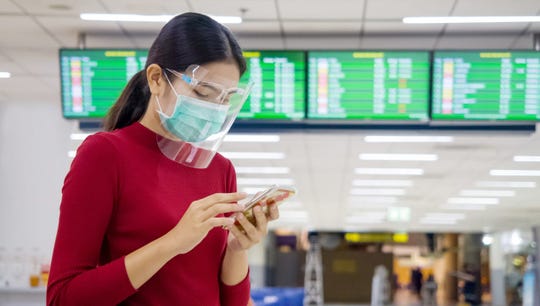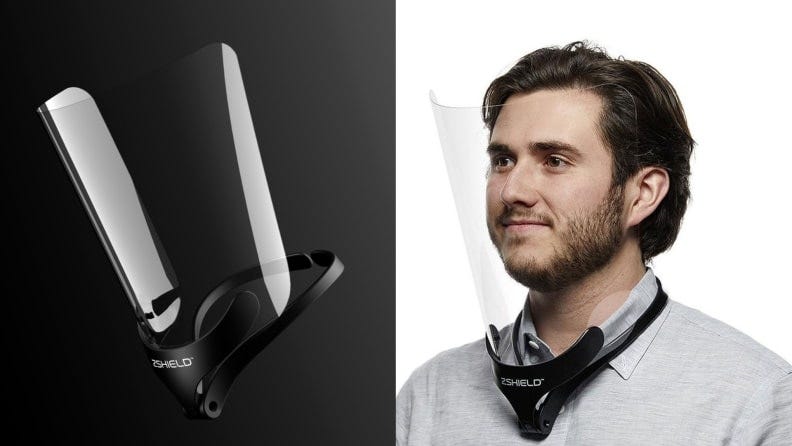
How to choose a face shield for travel, according to doctors
How to choose a face shield for travel, according to doctors (Photo: Reviewed.com)
— Recommendations are independently chosen by Reviewed’s editors. Purchases you make through our links may earn us a commission.
Planning a long-awaited vacation in 2021? As vaccinations roll out in the United States and beyond, doctors have made it clear that a return to normalcy will be slow and continue to require precautions.
The CDC released new guidelines on Tuesday saying that fully vaccinated people don’t need to wear a mask outside unless they are in a large crowd. Vaccinated individuals also do not need to mask up at small outdoor gatherings regardless members of the group’s vaccination status. The agency still strongly recommends wearing face masks outdoors for the non-vaccinated, and coverings are required for all at many indoor public places and when traveling.
Travel that involves planes, trains, or other vessels where people are contained within will demand the continued use of masks in the U.S., per a presidential executive order. However, “many viruses infect by entering mucus membranes,” like the eyes, says Shira Doron, hospital epidemiologist at Tufts Medical Center in Boston. “Therefore, the combination of a mask and eye protection are best to avoid getting the virus.” Even vaccinated individuals may worry about breakthrough cases, or those rare instances of COVID-19 that occur post-vaccine, and want to add extra protection, like a face shield.
What are face shields and what protection do they offer from COVID-19?
Face shields can offer protection for the eyes and an additional barrier for the nose and mouth over a face mask. (Photo: Getty Images / Hispanolistic)
The recommendation for eye protection in crowded environments has led to a boom in the use of face shields for travel. But what kind of face shields are best?
Experts say coverage and material are the most important factors to consider. The U.S. Centers for Disease Control (CDC) recommends that face shields “should cover the forehead, extend below the chin, and wrap around the side of the face.”
While some shields may be reusable, any face shield the wearer plans to reuse should not have any porous surfaces, like foam or fabric intended to cushion the face, says Tufts Medical Center’s Doron. In choosing a full face shield, she says: “The first thing I look at is whether every single element of the product is wipeable. It has to have no foam or soft or porous surfaces. If it does, then it must be discarded as soon as you take it off.”
If you want to protect your eyes from COVID-19 on the plane, here are some options that fit those requirements, in several styles to suit your preferences.
Face shields supported by a glasses’ frames
Face shields that clip to glasses (your own or a dedicated frame) may be the most comfortable yet easy-to-clean option. (Photo: Ceestyle / PRO-TEX Face Shields)
Unfortunately, many face shields utilize the foam the Doron warns against, typically as a cushion on the forehead for the shield to rest upon. One way to forgo that material is by using a face shield that utilizes built-in glasses’ frames or clips onto your own prescription frames.
If you don’t wear glasses, try an option with the frame already attached, like Ceestyle’s Reusable Face Shields that wipe clean and are free of porous surfaces. For the already bespectacled, this option from Pro-Tex is an eight-inch, clip-on face shield that attaches to most glasses frames along the temples with sturdy metal clips. It can also be wiped clean for reuse.
- Get a set of Ceestyle Reusable Face Shields at Amazon for $15.17
- Get a 12-pack of Face Shield Pro-Tex Long 8-inch Face Shields from Amazon for $52.40
Face shields that rest around the neck
Not a fan of a face shield that rests on your forehead? Try one that mounts on your neck. (Photo: Zshield)
For those not accustomed to wearing glasses for long periods of time, face shields that protect from the bottom up by looping around the neck and resting on the shoulders can be a more comfortable alternative. The ZShield Flex is a lightweight, adjustable face shield that extends upward from the base of the neck. It avoids any pressing on your face or forehead, while still covering both snugly thanks to an adjustable hinge. When not in use, the face shield also conveniently bends downward away from the face.
The size of the wearer’s face could impact this face mask’s efficacy. However, it should be adjusted to fit close to the face, and extend over the forehead, per the CDC’s face shield guidelines. If adjusted outward too far, this option could leave space between the forehead and shield that allows contaminants in from above.
Get the ZShield Flex Reusable Face Shield from Amazon for $19.99
Face shields that rest on the forehead without the porous foam
Forehead-resting face shields without the porous foam cushion are another option that is easy to clean. (Photo: Carestream Store / NoCry Store)
If neck- or eye-resting face shields don’t sound as comfortable as a simple forehead option, look for such an alternative that uses easy-to-clean plastic pads instead of porous foam. Adjustable Carestream face shields, for example, have a forehead cushion that’s made of a denser plastic (not foam) and an adjustable baseball-cap-like back strap, both of which can be sanitized. For an even more custom fit, the NoCry Flip Up Safety Face Shield uses a wipeable plastic headband with a drawstring at the rear for cinching—and the shield itself flips up when not in use.
- Get the Carestream face shields from Amazon for $14.99
- Get the NoCry Flip Up Safety Face Shield from Amazon for $12.99
Bonus buy: a spray to help face shields resist fogging
An effective solution to preventing breath condensation on your face shield is a long-lasting anti-fog spray. (Photo: Quick Sheen Store / Toondelamour)
One of the biggest complaints wearers have with face shields: annoying fogging from their own warm exhalations. Many shields come pretreated with anti-fogging properties, says David Freedman, an emeritus professor of epidemiology at the University of Alabama at Birmingham, which ensures the wearer does not sacrifice a close fit for clearer vision if and when the shield gets steamy from body heat.
If you find that yours gets steamy, a spritz with a basic anti-fog spray can do the trick, which is what medical professionals often use on polycarbonate goggle lenses or face shields.
Get Quick Sheen Anti-Fog Spray from Amazon for $15.95
Get expert shopping advice delivered to your phone. Sign up for text message alerts from the deal-hunting nerds at Reviewed.
The product experts at Reviewed have all your shopping needs covered. Follow Reviewed on Facebook, Twitter, and Instagram for the latest deals, product reviews, and more.
Prices were accurate at the time this article was published but may change over time.
Source: Read Full Article





